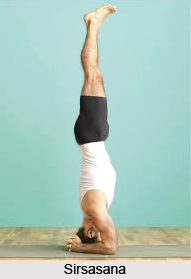 "The practice in which the navel is above and the palate below, the Sun above and the Moon below is known as Viparita Karani (topsy turvy pose), it can be learnt from the words uttered by a Guru. On the first day one should remain for a very short time with one`s head below and feet above. The duration of this practice should be gradually increased day by day. Sirsasana by its name is not found in old yogic texts. But above quoted verse of Viparita Karani suggest about Sirsasana."
"The practice in which the navel is above and the palate below, the Sun above and the Moon below is known as Viparita Karani (topsy turvy pose), it can be learnt from the words uttered by a Guru. On the first day one should remain for a very short time with one`s head below and feet above. The duration of this practice should be gradually increased day by day. Sirsasana by its name is not found in old yogic texts. But above quoted verse of Viparita Karani suggest about Sirsasana."
for Practice Sirsasana:
1. Sit on soles. place knees on the ground.
2. Frame finger lock with both hands.
3. Making a triangle from finger-lock and elbows, place it on ground.
4. Bending forward, place middle of the head on the ground near finger-lock.
5. Now straighten your legs.
6. Slowly bring the legs neck your body.
7. Soles will automatically leave the ground by practice and thighs knees will touch the abdomen.
8. Now keeping the balance straighten your legs from thigh-joint, knees will remain folded.
9. Now straighten the knees also and completely balance your body on head.
10. While returning to the original position fold your knee first. Then fold your legs from thigh and let the thigh and knee touch your abdomen.
11. Now slowly place the soles on the ground. Slowly raise your head also and sit on soles.
Benefits of Sirsasana
1. This increases the blood circulation in head and memory power is improved.
2. This strengthens the nervous-centres of the whole body and maintains the health of endocrine gland.
3. Digestive system is also benefited through this Asana.
4. According to Swami Kuvalayanandaji, it is beneficial against congested throat, diseases of liver and spleen and in Visceroptosis.
5. Calms the mind.
6. Strengthens the arms, legs, and spine.
7. Improves balance.
Precautions during Sirsasana
1. While practicing Sirsasana, place that part of your head on the ground on which the spine can remain erect.
2. Do not raise your legs with jerk. Slow and gradual practice will "raise your legs up automatically.
3. In the beginning practice it under the guidance of a teacher because there is a fear of falling down.
4. While returning, do not raise your head soon after completing Asana. There remains a fear of getting giddiness. Therefore, keep your head near finger-lock for some time and then raise it up.
5. Those suffering from high blood pressure, running ear or heart disease should not practice it.
6. Those having cough or chronic cold also should not practice it.
7. Persons suffering from constipation should practice it carefully
Beginner`s tip:Practice the pose at the wall. Try to move further from the wall each time. Try removing one foot and then the other from the wall to practice balancing.



